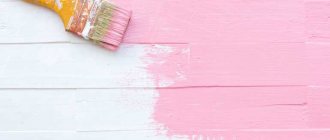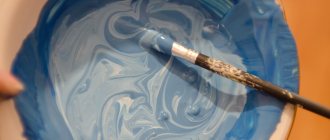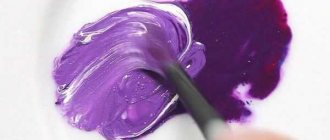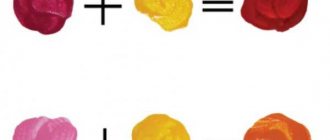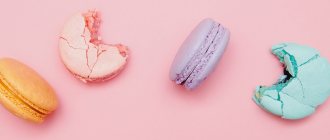» How to get color » How to get pink by mixing paints
It is believed that pink is a light shade of red, but bright colors such as fuchsia or crimson have a different nature. My package of acrylic paints did not contain pink, but there were two red colors: dark red and carmine. Dark frame has a rich, distinctly warm undertone, and carmine is a purple-crimson. It is these two tones of red that will be able to reveal the entire palette of pink, and if you only have one warm color, then rich fuchsia-magenta shades will have to be obtained by mixing red + white and blue, and this is a third-order color that will not have saturation, but only a faded medium pink tone.
How to get fuchsia pink by mixing paints?
Bright, cold pink, according to some theories, is considered a primary color, so you can get red from it, but from red we cannot get fuchsia, but only imitate its pale likeness. So, for example, take red paint, white, blue (ultramarine), mix in proportions of approximately 100:30:5 and get a medium, cool pink color, reminiscent of fuchsia.
If, to obtain the desired color, we take not warm red paint, but carmine, a rich purple-red color, then we will not have to resort to blue, since even lightly highlighting it will give the desired effect. Very light dilution gives a rich raspberry color, and a little more intense dilution gives fuchsia or magenta.
How to get a medium pink warm or cool?
Rich fuchsia in a pink palette is the exception rather than the rule. The main range of tones lies in the light area and therefore a sufficient amount of white helps to form many shades of pink: both warm and cold. Mixing white and red, with both fiery and purple undertones, leads to the formation of a palette of this color. Carmine and white, which is at least half of the first component and more (with increasing lightness), form soft, medium-cold, pure pink paints.
Dark red and white, which has no less share than in the previous case, create soft, warm tones of pink.
However, these colors can be made even warmer by adding a small amount of yellow.
In general, these will turn out to be coral-pink tones, which, with increasing lightness, will gain the aesthetics of pink.
Preparatory stage
Before mixing paints, you should prepare a suitable surface, for artists this is a palette, for interior designers - a container. Prepare red and yellow paint and brushes. To obtain an ideal result, you need to make sure that there are no foreign particles (dust, various hairs) on the working surface.
It is important to decide and decide which mixing method to use in order to get the result. If the mixing process is performed on paper, then the result can be obtained by overlapping previous tones. When dyes are mixed in jars or on a palette, a new tone is created.
How to get complex shades of pink?
There are always significantly fewer pure tones than complex and clouded ones, but the ability to create the latter is more widely applicable, since these are more natural shades that are located in the light or in the shadows and fit organically into palettes and compositions. Most often, these tones consist of 3 or more primary colors. For example, warm shades of lilac: ash rose. As a basis, we take a shade obtained by mixing dark red, yellow and white and add a drop of blue (ultramarine) to it.
The resulting tone is soft, but has a pronounced grayish tint. For a darker version of this color scheme, add a little more blue and dark red.
Laws of color mixing
To obtain new tones when mixing paints, you need to familiarize yourself with the basic rules of color, which are invariably observed in construction, design, and painting. According to science, there are chromatic colors - bright, colorful shades, as well as achromatic ones - gray, white, black.
The ash shade is unique in its own way. Any chromatic color has an additional tone, when combined with which it forms gray. This is the first law of color mixing. Other recommendations are:
- when combining two primary colors that are closer in a circle than additional ones, the new shade will be located between them in tone along a smaller arc of the circle,
- two colors when combined make it possible to obtain a shade that is always intermediate in chromaticity between the original ones,
- when mixing two tones of equal chromaticity, the same color will be obtained, regardless of the spectral composition of the original ones.
How to get purple color?
One of the most popular shades of pink is lilac. Complex tone from very light to dark colors. It is obtained by mixing medium pink with blue and red in different proportions.
It is also possible to obtain it by mixing white, warm or cold red with blue (Prussian blue). The amount of white will control the saturation and darkness of the mauve pink.
Additionally, you can darken it with black, but you will need a very small amount.
You can also get a very dark lingonberry shade using dark red.
Laws of color mixing
To obtain new tones when mixing paints, you need to familiarize yourself with the basic rules of color, which are invariably observed in construction, design, and painting. According to science, there are chromatic colors - bright, colorful shades, as well as achromatic ones - gray, white, black.
The ash shade is unique in its own way. Any chromatic color has an additional tone, when combined with which it forms gray. This is the first law of color mixing. Other recommendations are:
- when combining two primary colors that are closer in a circle than additional ones, the new shade will be located between them in tone along a smaller arc of the circle;
- two colors when combined make it possible to obtain a shade that is always intermediate in chromaticity between the original ones;
- when mixing two tones of equal chromaticity, the same color will be obtained, regardless of the spectral composition of the original ones.
How to get cooler fuchsia pinks?
As we see in all cases where blue is used, the color acquires a dirty impurity, but if we use carmine, whose color includes the display of the blue spectrum, then creating a tertiary color based on purple-red, white and blue will not be so destructive to it saturation.
This is also due to the fact that to create the paint you will need a very small amount of additional paint: 100:20:5. By diluting the resulting paints with white, we get medium pink colors: cold and bright.
Mix two hair dyes of different colors.
I have chocolate-colored hair, but I want chestnut-dark reddish hair, I’m thinking, if you mix, for example, chocolate and red thread or chestnut, won’t a scribe happen? What's the best way to do it if you don't go to the salon?
Guest
better go to the salon, you'll get confused
Miki
I would mix, of course, the same brand, of course. You can’t mix blonde with dark, they have different principles of action, but those that are similar in color are easy
Larisa
I think it will turn out dark red. I mixed light wheat with copper - it turned out so naturally red, a little lighter than it would have turned out without wheat.
Kim
a new topic pops up: “ruined my hair.Help”
Author
I was afraid, I bought chocolate again
Guest
There are so many colors now, can’t you really choose the color you need?
Guest
There's nothing to be afraid of. I constantly mix, as mentioned above, paints of the same brand. I mix dark or regular brown and light brown. Looks much better than just one shade
Lapyshistik
actually l▓oreal has a cool color - p50 genuine amber
Musya
And you can still cook lipsticks. But why???
Elena
I want to dye my hair in a light tone, now my color is chocolate, and I want the color tea with milk. How can I achieve this color? What shades should I mix?
Tatiana
Is it possible to mix essential color shades 205 and 219?
Maria
I want to turn half my head white from black in one go, what do I need for this?
Nadisha
Maria, excuse me, of course, but you should watch the movie “101 Dalmatians” there was such a heroine)))))))))))))))))))))))
Maria
I want a color like beard’s, what colors should I mix?
Maria
https://kontrasti.Ucoz.Ru/_pu/56/68376828.Jpg
Hairdresser
Girls mixing household paint is a bit risky. If you don't know the basics of color. All “dark” shades starting from level 7 contain green pigments, and each paint is mixed individually to suppress or enhance a particular tone. Masters also mix dyes individually for each client’s hair color/type, and not because of a whim to create an ambience, or the salon simply does not have the desired shade, then the shade is created and the recipe can be repeated by the same master, observing the proportions. But a tube of one household product plus a tube of a second household product will never produce a beautiful and correct color. Even if looking in the mirror it seems to you that the color turned out good. Stand next to a person whose color was chosen by the master in the salon and you will see the difference. If you really want to save money, go to the salon once, let the specialist select the shade, share the recipe and brand of product and the percentage of oxide, and you will already buy professional. Apply cosmetics yourself and you will be happy.
Marina
Girls, please tell me if you mix chocolate and dark chocolate of different names, one color is called Estelle and the other is Londa!! What color will you get, and is it possible to do this????
woman.ru>
Table for obtaining shades of pink when mixing colors
This table shows how other colors influence the development of pink shades and how their undertone changes. The center is the main tone, around it are the primary colors for mixing, then to the periphery are the products of mixing the main tone and the adjacent shade in a ratio of 100:50, and then the percentage decreases to 100:20. Next to the main mixing product, the shades are darkened by 20% black and lightened by 20% white.
How to get other colors and their shades: theory and practice. Click on the icon.
One comment on “How to get pink by mixing paints”
- Vlad
March 4, 2021, 1:17 am
Thanks a lot.
Laws of color mixing
To obtain new tones when mixing paints, you need to familiarize yourself with the basic rules of color, which are invariably observed in construction, design, and painting. According to science, there are chromatic colors - bright, colorful shades, as well as achromatic ones - gray, white, black.
The ash shade is unique in its own way. Any chromatic color has an additional tone, when combined with which it forms gray. This is the first law of color mixing. Other recommendations are:
- when combining two primary colors that are closer in a circle than additional ones, the new shade will be located between them in tone along a smaller arc of the circle,
- two colors when combined make it possible to obtain a shade that is always intermediate in chromaticity between the original ones,
- when mixing two tones of equal chromaticity, the same color will be obtained, regardless of the spectral composition of the original ones.
